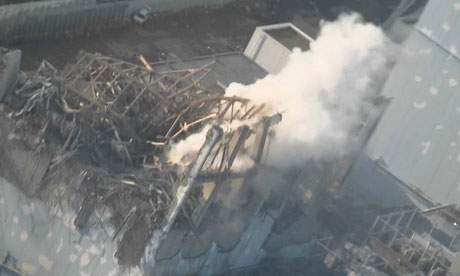Race is on to restart cooling systems with emergency power after dropping water on damaged reactors has little effect

Helicopter crews and teams of police officers in water cannon trucks are battling intense radiation at the crippled Fukushima power station in Japan in a desperate bid to douse overheating fuel rods with tonnes of water.
Authorities have drafted in extra workers and turned to ever more radical tactics as fears grow that pools used to cool down spent fuel rods have leaked, leaving the rods exposed and in danger of catching fire, which could release huge amounts of radiation into the air.Tepco, the company that operates the plant, has increased its workforce at the power station from 180 to 322 and replaced those who have reached – or in some cases surpassed – the maximum allowed dose of radiation.
The emergency workers focused their efforts on the storage pool at reactor 3, the only unit at the site that runs on mixed oxide fuel, which contains reclaimed plutonium. The strategy appeared to conflict with comments made by US nuclear officials and Sir John Beddington, the UK government's chief science adviser, who are most concerned about the storage pool at reactor 4, which they say is now completely empty.
"The water is pretty much gone," Beddington said, adding that storage pools at reactors 5 and 6 were leaking. "We are extremely worried about that. The reason we are worried is that there is a substantial volume of material there and this, once it's open to the air and starting to heat up, can start to emit significant amounts of radiation."
The storage pools are supposed to be kept below 25C to keep the spent fuel rods from heating up, but temperature readings at the ponds in reactor buildings 4, 5 and 6 show temperatures have been rising this week, to around 60C in pools 5 and 6 and at least 84C at reactor 4.
The government has urged British citizens to move at least 50 miles from the Fukushima 1 plant, in line with an exclusion zone declared by the US Nuclear Regulatory Commission. Britain's Met Office said it had begun sophisticated modelling of the radiation plume and was passing that information to the Cobra emergency committee but not making it public. The Japanese authorities maintained that their 20km exclusion zone was sufficient, with those within 30km advised to seal their homes and stay indoors.
The concern with reactor 3 appears to stem from an explosion on Monday that is thought to have damaged the primary containment facility around the reactor's core. If the storage pool at the reactor runs dry, radiation levels could soar so high that engineers cannot approach the reactor to try and bring it under control. David Lochbaum, a nuclear physicist for the Union of Concerned Scientists and a former Nuclear Regulatory Commission safety instructor, said the level of radiation beside the exposed rods would deliver a fatal dose in 16 seconds.
The frantic attempts to refill the leaking storage pool came as engineers installed a kilometre-long power cable to replace those destroyed in last Friday's earthquake and reconnect the power plant to the grid. Engineers said the power supply would first provide electricity to reactor 2. Japan's Nuclear and Industrial Safety Agency (Nisa) said three of the plant's six reactors – numbers 1, 5 and 6 – were relatively stable.
The fresh power supply will be used to drive pumps that are needed at three of the reactors to circulate seawater and prevent their nuclear cores from going into meltdown. The water levels in all three reactors are dangerously low, exposing between 1.4m and 2.3m of the fuel rods, according to Nisa. The fuel rods should be covered with water at all times to prevent meltdown.
The UN nuclear watchdog said engineers were able to lay an external grid power cable to reactor 2 and would reconnect it "once the spraying of water on the unit 3 reactor building is completed". It said water cannons had temporarily stopped spraying reactor 2 at 1109 GMT.
Five teams of police officers in water cannon trucks have tried to get close enough to reactor 3 to douse the storage ponds but were forced back after an hour when radiation rose to a dangerous level.
Minutes later military helicopters flew overhead and dropped 30 tonnes of water, but from such a height much of it appeared to miss the target. The storage pools are located in the top level of the reactor buildings and are exposed at reactors 1 and 3 because hydrogen explosions have torn their roofs off. Hidehiko Nishiyama, deputy director general of Nisa, said it was unclear whether the strategy had succeeded in topping up the ponds.

No comments:
Post a Comment